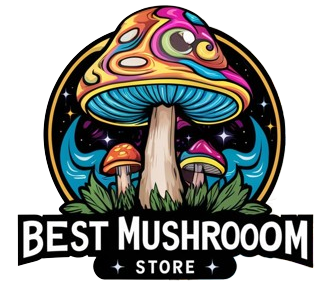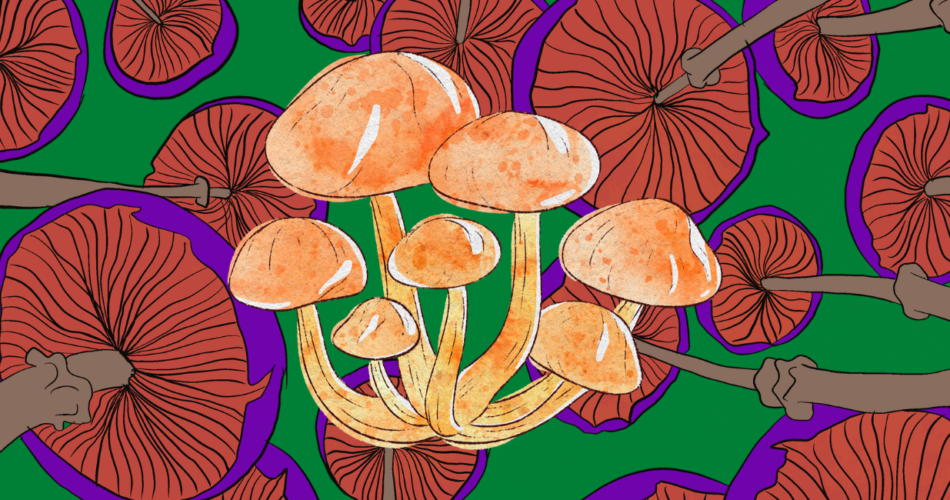Interestingly, the Psilocybe allenii spores are known for being some of the largest in the world! In this post, we’ll provide more information about this unique mushroom, including its spore print color and other identifying factors.
In this post, we will cover the Psilocybe allenii, a species of magic mushroom that is common in the Pacific Northwest. We will provide information on its physical characteristics, where it grows, and how to identify it.
Psilocybe Allenii – Morphology
In 2012, the identification of Psilocybe allenii was published by Jan Borovička, Alan Rockefeller, and Peter G. Werner. If you go to Golden Gate Park in December you will see hundreds of hippies looking at the wood chip landscaping for Psilocybe cyanescens and Psilocybe allenii – that’s the words of Rockefeller.
Psilocybe allenii is a small to medium-sized mushroom with a conical or bell shaped cap. The cap is 2-6 cm in diameter and has a convex to flat shape. The surface of the cap is smooth and sticky when wet. It is orange brown to caramel brown in color with lighter colored margins. The gills are adnexed to free and are pale brown to reddish brown in color. The spores are dark brown, ellipsoid shape and measure 9-12 x 6-8 microns.
Is Psilocybe Allenii a Magic Mushroom?
Psilocybe allenii is a magic mushroom that is native to North America. This shroom has a long history of use by indigenous peoples of the Americas. It is known for its hallucinogenic properties – it contains psilocybin and psilocin, which are the active ingredients in many psychedelic drugs. This mushroom is also known to cause a sense of euphoria and well-being.
The Psilocybe allenii is not considered to be dangerous and there are no known side effects associated with its use. However, as with all drugs, there is a potential for abuse and addiction. If you or someone you know is struggling with an addiction to any drug, please seek help from a qualified medical professional.
Psilocybe Allenii – Habitat
Psilocybe allenii is a rare psychedelic mushroom that grows in the Pacific Northwest of North America. This species is closely related to Psilocybe cyanescens, and both are distinguished from other members of the genus by their small size and blue bruising.
This mushroom is relatively rare, and is only found in a few bay areas of the Pacific coast. It is most commonly found in Oregon and Washington, but has also been reported from British Columbia and Idaho.
Psilocybe allenii typically grows on moist wood chips or bark mulch in urban areas, and is often mistaken for a common lawn fungus.
How to Identify a Psilocybe Allenii, Cultivation
The mushrooms are small, brownish, and have a conical cap with a broad umbo. The gills are adnate to subadnate, and the spores are dark purple-brown.
Psilocybe allenii is not known to be cultivated, and little is known about its natural history. However, it is suspected that this mushroom fruits in the late summer or early fall.
If you find Psilocybe allenii in the wild, be sure to take care when handling them. These mushrooms can easily be mistaken for poisonous species, and ingesting them can cause serious illness or death. If you are not experienced in mushroom identification, it is best to leave this task to a professional.
Psilocybe Allenii – Potency
Psilocybe allenii is a potent magic mushroom that contains high levels of psilocybin and psilocin. This makes it one of the most popular choice for those looking for a powerful psychedelic experience. However, it’s also important to note that P. allenii can be quite variable in terms of potency. Some samples may only contain trace amounts of psilocybin/psilocin, while others can be extremely potent.
Is Psilocybe Allenii Legal?
The legality of Psilocybe allenii is currently unclear. The mushroom is not specifically mentioned in the United States Code of Federal Regulations, and it is not listed as a controlled substance by any state government. However, it does contain the psychoactive compound psilocybin, which is a Schedule I drug under the federal Controlled Substances Act. This means that it is illegal to manufacture, possess, or sell psilocybin in the United States.
Now you know more about this unique fungus. Thanks for reading!
Similar Posts:
- Psilocybe Guilartensis: A Potent Psilocybin Mushroom From Puerto Rico. Morphology, Habitat & Interesting Facts
- Psilocybe Subcaerulipes: A Japanese Mushroom That Contains Psilocybin. History & Morphology of the Species
- Psilocybe Bohemica: A Psilocybin Mushroom From Europe. All the Information You Need to Know About the Species
- Psilocybe Baeocystis – Unusual Psilocybin Species. Identification, Potency & Characteristics
- Galerina Steglichii: A Very Rare and Mysterious Psilocybin Mushroom Found in a Greenhouse
- Psilocybe Subaeruginosa: Magic Mushroom From Australia. Spore Prints, Cultivation, Psilocybin Content
- Alacabenzi Cubensis: A Hybrid Magic Mushroom with Powerful and Unique Effects







Very reckless with our safety when you post a picture of a poisonous mushroom over an fun boomer description. Check your facts and confirm photos. Please fix this
We are currently working on fixing past articles. Thank you for being vigilant, and please be patient as we’re trying to improve our site. Thank you!